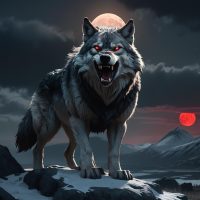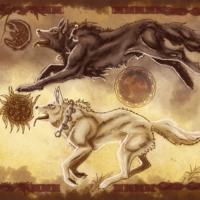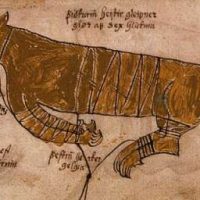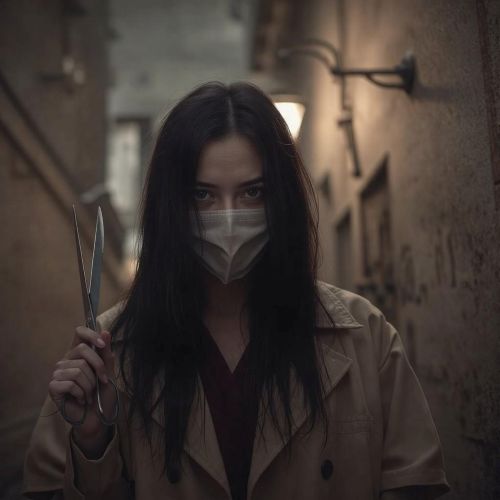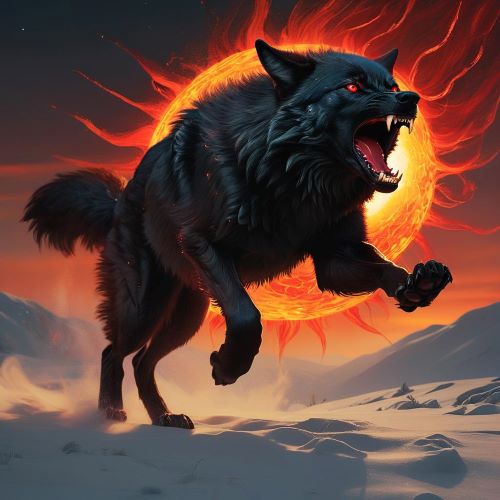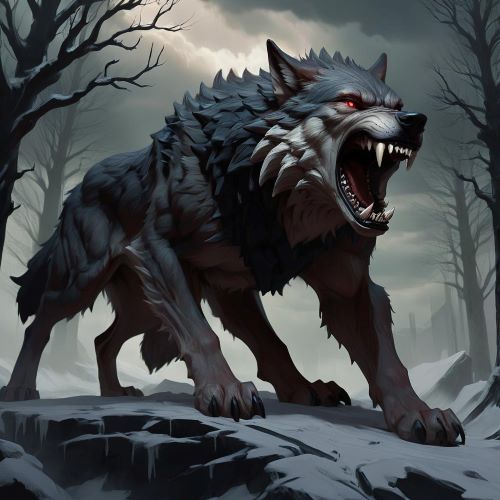Hati : The Moon Hunter
Listen
At a glance
| Description | |
|---|---|
| Origin | Norse Mythology |
| Classification | Animals |
| Family Members | Loki (Grandfather), Fenrir (Father), Skoll (Sibling) |
| Region | Iceland, Norway, Denmark, Finland |
| Associated With | Moon |
Hati
Introduction
Hati Hróðvitnisson, also known simply as Hati, commands a prominent place in Norse mythology as a warg, a colossal wolf whose relentless pursuit of the moon across the night sky reflects the ancient Norse perception of the cosmos. His name, translating to “He Who Hates” or simply “Enemy,” encapsulates his role as a harbinger of destruction. In the intricate tapestry of Norse lore, Hati emerges as a formidable embodiment of primal forces and the inexorable march of fate.
Depicted as a relentless wolf in pursuit of the moon, Hati’s presence evokes a blend of fear and fascination among those who explore the ancient narratives of the Norse cosmos. This formidable creature embodies the unyielding power of devastation, feared and revered in equal measure. With unrelenting determination, Hati chases the moon through the night sky, destined to fulfill his role in Ragnarök, the cataclysmic end of the world.
Physical Traits
Descriptions of Hati’s physical form within Norse mythology are fragmented, yet they coalesce to create an image of a fearsome creature. Often portrayed as a monstrous wolf of colossal proportions, Hati’s fur is typically depicted as dark, either black or grey, mirroring the ominous nature of its pursuit. Some renditions illustrate Hati with fiery red eyes, emanating a relentless hunger that mirrors its ceaseless chase. In the Prose Edda, compiled in the 13th century by Snorri Sturluson, Hati is referenced as one of the two wolves destined to consume the heavenly bodies. Sturluson hints at Hati’s immense size, likening the wolf’s hue to that of the sun, suggesting a creature comparable in stature to the celestial body it pursues. Scholars speculate that Hati’s monstrous depiction may stem from the prevalent fear of wolves in Viking society. Wolves were perceived as a significant threat to Viking livestock and safety, and Hati’s portrayal could symbolize this fear on a cosmic scale.
As a warg, Hati is often depicted as a colossal wolf in Norse sagas and poems, although specific physical details are sparse. Nevertheless, emphasis is placed on his size and strength, portraying him with fierce eyes, sharp teeth, and a powerful physique that embodies the untamed forces of nature. With fur as dark as the night’s depths and eyes gleaming like twin orbs of silver, Hati exudes an aura of primal intelligence honed through eons of relentless hunting. His iconic portrayal involves the perpetual pursuit of the moon, symbolizing a cosmic chase transcending time itself.
Family
Hati is not a lone figure but rather part of a destined pair. His counterpart, Skoll, is another monstrous wolf whose relentless pursuit is aimed at the sun. Together, they symbolize the inexorable passage of time and the cyclical pattern of destruction and renewal. Hati’s lineage can be traced back to Fenrir, the monstrous wolf foretold to bring about the demise of Odin, the Allfather, during Ragnarök. Fenrir, in turn, is the offspring of Loki, the cunning trickster god, and Angrboda, a giantess known for her association with monstrous progeny. Alongside Hati and Skoll, their siblings include the monstrous serpent Jörmungandr and the ruler of the underworld, Hel. Bound by fate, they are destined to play pivotal roles in the cataclysmic events of the end times.
Hati’s parentage is deeply intertwined with the intricate tapestry of Norse mythology. Legend holds that he is the son of Hrímgerðr, a giantess of immense power and primordial chaos. His father, Fenrir, strikes fear into the hearts of both gods and mortals alike. As the offspring of such formidable beings, Hati inherits not only their strength but also their insatiable hunger for dominion. Within the Norse pantheon, Hati’s familial connections serve as a testament to the complex interplay between order and chaos that shapes the cosmos.
Other names
While Hati is predominantly recognized as the wolf who pursues the moon, there exist alternative names or titles hinted at in fragmented sources. Some scholars propose the possibility that Hati could be synonymous with Mánagarmr, another wolf associated with the moon’s destruction during Ragnarök. The name Mánagarmr, translating to “Moon-Maimer,” underscores the creature’s role in destruction. Nonetheless, there remains a lack of definitive consensus regarding whether Hati and Mánagarmr represent distinct entities or are simply different appellations for the same celestial wolf.
Apart from Hati, there are other epithets in Norse mythology that reference this celestial wolf. One such designation is “Hati Hróðvitnisson,” translating to “Hati, Son of Hróðvitnir.” This title accentuates his lineage from Fenrir, also known as Hróðvitnir, which means “Fame-wolf.” These alternative names enrich our understanding of Hati’s connections to his ancestry and the broader mythological realm, adding layers of significance to his character.
Powers and Abilities
Hati’s primary attribute lies in his unmatched strength and speed, enabling him to tirelessly pursue the moon across the sky. As a celestial being, he embodies the relentless march of time and the cyclical patterns of existence. His formidable power is prophesied to culminate in the swallowing of the moon, signaling the advent of Ragnarök, the world’s end. Endowed with boundless stamina, Hati’s relentless chase through the night sky is driven by an insatiable hunger, foretelling the moon’s eventual demise during Ragnarök.
While certain interpretations suggest Hati possesses a supernatural connection to the moon, with its phases possibly influencing the creature’s strength or behavior, concrete evidence supporting this theory is scarce. Beyond its physical prowess, Hati assumes a symbolic role in Norse mythology, embodying the inevitable decay that awaits all things. The moon, symbolizing time and renewal, is not exempt from this fate. Hati’s unwavering pursuit serves as a testament to the cyclicality of existence, wherein destruction yields to eventual rebirth.
As a creature steeped in myth and legend, Hati boasts a diverse array of powers and abilities befitting his status as a cosmic predator. Foremost among these is his unmatched speed and agility, facilitating effortless traversal of the vast cosmic expanse. Augmented by acute senses and innate cunning, Hati stands as an unparalleled hunter, capable of tracking even the most elusive quarry across the nocturnal heavens.
Furthermore, Hati’s celestial ties afford him a unique sway over the natural world. In Norse mythology, his pursuit of the moon during lunar eclipses symbolizes an endeavor to consume this celestial body, presaging Ragnarök’s cataclysmic advent. This association with cosmic phenomena underscores Hati’s role as a harbinger of destiny, shaping the fate of both gods and mortals alike.
Modern Day Influence
Hati’s enduring influence permeates modern popular culture, particularly within fantasy literature and gaming realms. Often portrayed as a formidable wolf character or symbolizing destructive forces, his presence evokes a dramatic imagery that continues to captivate and inspire imaginations. Despite originating from ancient mythological traditions, Hati’s impact persists in contemporary times across various artistic mediums, including literature, cinema, and gaming platforms. From novels and comics to films and video games, Hati’s mysterious allure captivates global audiences, beckoning them to delve into the depths of Norse mythology and its timeless narratives.
In contemporary popular culture, Hati’s presence remains palpable. Whether featured in video games like Smite or Dungeons & Dragons, or serving as inspiration for heavy metal bands and dark fantasy novels, Hati’s depiction as a monstrous devourer resonates with creators seeking to convey themes of raw power and the inevitability of decay. The iconic image of Hati in pursuit of the moon has also found its place in the realm of body art, with tattoos depicting this scene gaining popularity, especially among enthusiasts of Norse mythology or those drawn to the symbolism of wolves and lunar cycles. These tattoos carry diverse meanings, ranging from representing the pursuit of personal goals to symbolizing the cyclical nature of life or serving as a poignant reminder of the transient nature of existence.
Related Images
Frequently Asked Questions
What is lorem Ipsum?
I am text block. Click edit button to change this text. Lorem ipsum dolor sit amet, consectetur adipiscing elit. Ut elit tellus, luctus nec ullamcorper mattis, pulvinar dapibus leo.
What is lorem Ipsum?
I am text block. Click edit button to change this text. Lorem ipsum dolor sit amet, consectetur adipiscing elit. Ut elit tellus, luctus nec ullamcorper mattis, pulvinar dapibus leo.
What is lorem Ipsum?
I am text block. Click edit button to change this text. Lorem ipsum dolor sit amet, consectetur adipiscing elit. Ut elit tellus, luctus nec ullamcorper mattis, pulvinar dapibus leo.
What is lorem Ipsum?
I am text block. Click edit button to change this text. Lorem ipsum dolor sit amet, consectetur adipiscing elit. Ut elit tellus, luctus nec ullamcorper mattis, pulvinar dapibus leo.
What is lorem Ipsum?
I am text block. Click edit button to change this text. Lorem ipsum dolor sit amet, consectetur adipiscing elit. Ut elit tellus, luctus nec ullamcorper mattis, pulvinar dapibus leo.

